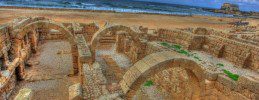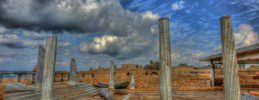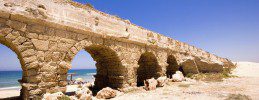Ancient City of Caesarea
January 13th 2015
The ancient city of Caesarea was built by Herod the Great during the period of Roman rule and served as a major port. Here we can visit lengths of aqueducts, a fortress, an ancient marina and a magnificent amphitheater – all alongside one of the Israeli coast’s most pristine beaches and upscale residential communities.
 Caesarea was the administrative center for the Province of Judea in the Roman Empire, retaining this status under the Byzantine Empire as well. The town was abandoned during Mamluk rule and repopulated by Muslims in the late 19th century. The population fled during the 1948 War of Independence, and an Israeli town was founded on the site in 1952.
Caesarea was the administrative center for the Province of Judea in the Roman Empire, retaining this status under the Byzantine Empire as well. The town was abandoned during Mamluk rule and repopulated by Muslims in the late 19th century. The population fled during the 1948 War of Independence, and an Israeli town was founded on the site in 1952.
 Start your tour of Caesarea with a visit to Caesarea National Park. The ruins of Herod’s palace are on view, as well as the oldest surviving Roman theater in the eastern Mediterranean. The park also houses a hippodrome, used for chariot racing, an ancient synagogue and Byzantine bathhouses.
Start your tour of Caesarea with a visit to Caesarea National Park. The ruins of Herod’s palace are on view, as well as the oldest surviving Roman theater in the eastern Mediterranean. The park also houses a hippodrome, used for chariot racing, an ancient synagogue and Byzantine bathhouses.

A sophisticated system of drawing water to the ancient city was made up of aqueducts channeling water from various springs into Caesarea. Herod began construction on the aqueducts, and the system was extended over the years. In warm weather, take a swim in the Mediterranean to round off your visit. And don’t miss the view of the sea from the heights of the Roman theater and a walk along the promenade at sunset.
The Rally Museum of Art in Caesarea exhibits primarily Latin-American art from the private collection of the scion of an Israeli banking family. It is located in a beautiful Spanish-style house in the city. Admission is free.While in Caesarea, visitors should head to the Time Tower, which provides visitors with a virtual tour of the city during the period of Herod the Great. There is also a Travel Through Time Display – a ten-minute multimedia presentation showing Caesarea through the years, from a Phoenician port to what it is today. An interactive experience called Caesarea Stars introduces you to key figures who shaped Caesarea’s history. Meet three-dimensional heroes such as King Herod, Rabbi Akiva, Paul, Saladin, Hannah Senesh and Baron Rothschild.
The Hannah Senesh House in nearby Sdot Yam tells the story of the feminine hero of British Mandate Palestine. Senesh performed rescue missions in Nazi Europe during World War II and was a poet as well. She was executed after being caught on one of her paratrooping missions and refusing to give up any crucial information.












